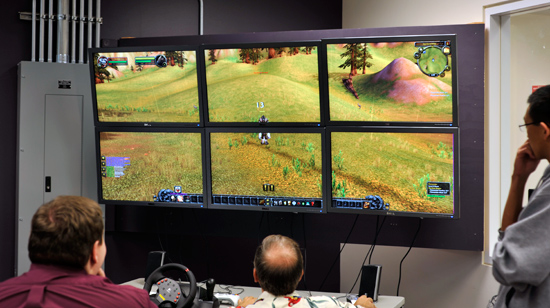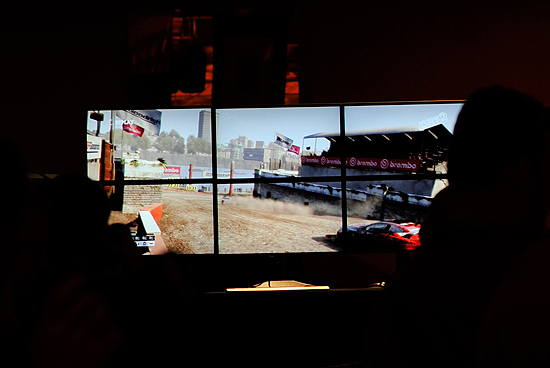Beginnings of the Holodeck: AMD's DX11 GPU, Eyefinity and 6 Display Outputs
by Anand Lal Shimpi on September 10, 2009 2:30 PM EST- Posted in
- GPUs
The First Generation Holodeck by 2016
When AMD first told me about the RV770 they told me another interesting story. For the past several years AMD (and ATI before it) has been obsessed with trying to figure out when it would be possible to render an image so convincing that it was indistinguishable (at least mostly) from reality.
Given the right art and a good technique to render the scene, this is totally possible not only within our lifetimes but within the next decade. Unfortunately, that's not enough.
Carrell estimates that the human eye can directly resolve around 7 million pixels, almost twice the resolution of a 30" display. But that's just what it's directly focusing on, all of the peripherial vision brings the total up to around 100 million pixels. The Eyefinity demo I showed earlier was running at 24.5 million pixels on a single GPU; you can estimate that at this generation we'll be able to do about 50 million pixels with two GPUs and one more generation from now we'll get to that 100 million pixel marker. That's two years for a single GPU. Then give it a few more years to be able to render that many pixels but with enough complexity to actually look real.
Rendering something at the max resolution that the human eye can resolve isn't enough however; you have to feel immersed in the graphics. That's where Eyefinity comes in, at least what it starts to come in.
Carrell believes that in seven years we can have the first generation Holodeck up and running. For those of you who aren't familiar with the Trek reference, Carrell believes it'll take seven years to be able to deliver a 180 degree hemispherical display (you're not completely surrounded by displays but at least your forward and peripheral vision is) with positionally accurate and phase accurate sound (both calculated by the GPU in real time). The GPU will also be used to recognize speech, track gestures and track eye movement/position.
It doesn't solve the issue of not being able to walk forward indefinitely, but again this is only the first generation Holodeck.
Eyefinity isn't anywhere close, but if you understand the direction: it's a start.

We're at six 2560 x 1600 displays today, is it too far fetched to imagine a totally immersive display setup that renders at life-like resolutions?
First person shooters pretty much dictate that you'll need an odd number of displays to avoid your crosshairs spanning multiple monitors. With three displays you can begin to get the immersion effect, but buy five and you'll be completely surrounded by your game. And as I mentioned before, it doesn't require any special application or OS support, the drivers take care of everything: it just appears as a single, large, surface.
It seems trivial but honestly we haven't had the ability to easily support the ridiculous display setups we always see in sci-fi movies. Eyefinity at least makes it look like we can build the PCs from the Matrix.
Will it succeed? Who knows. Does it sound gimmicky? Sure. Is it cool? Yeah, I'd say so.

If panel prices could drop significantly enough where putting together an Eyefinity display setup didn't cost more than the graphics card, I think it'd be a much easier sell. Obviously AMD's next-generation GPU is more than just Eyefinity, but you'll hear about the rest late this month.










137 Comments
View All Comments
SkullOne - Thursday, September 10, 2009 - link
That is true but you're not seeing the big picture and yes that pun was intentional.Current monitors strapped together like in the demo are worthless for things like L4D or Counter-Strike. But what about future monitors? I can see vendors building a single giant monitor built from 3 or 6 or more monitors and making them a more or less seamless and market those to the extremely hardcore gamer.
Visual - Friday, September 11, 2009 - link
Ok, but then why not just have it be one monitor to begin with?One whole panel will always be better than pieces strapped together even if they are without bezels. One single video port and cable, even if it is "six-link displayport" or some other freaky name will be better than multiple cables.
Penti - Sunday, September 13, 2009 - link
For games yes it's useless, but have you ever seen the gigapixel projects (and the displays for viewing very high resolution images) universities do? This will simplify it brutally, before they had a PC for every screen or two and rendered with software. Now they can just connect them to a single desktop if 6 displays is all they need, or when running with software rendering cut down the number of PCs by a factor of 3. When you need high resolution you can't just use one big display (or projector) because the resolution will be to low for that stuff.On the other hand, this is just for displaying the multi-monitor capabilities and people use more then one monitor in the real world, maybe not as one giant screen (they do that too of course) but that's not the point that is just one of the mode you can use. And for those who use that mode it's now greatly simplified, before it was a hell getting acceleration and stuff working across both screens at the same time or stretch some apps across the two screens, this is now no problem as it's just one single surface for windows and the applications. But as said you simply can't build a single display with a resolution of say 11520 x 6480.
Havor - Saturday, September 12, 2009 - link
[quote]One single video port and cable, even if it is "six-link displayport" or some other freaky name will be better than multiple cables. [/quote]Is there a problem i don't see ?
Its the same as whit RGB cables you have 3 of them together and only the ends fan out.
Not seeing the problem here
Ratinator - Friday, September 11, 2009 - link
How many monitors have you seen that can do a 10240 x 3200 display? I think that was part of the points of this demo as well is the throughput of the card. Techology ain't there yet. This is where the flexible panels of the future will shine.Ratinator - Friday, September 11, 2009 - link
Meant 7680x3200slowside - Friday, September 11, 2009 - link
Cost & manufacturing complexity. It is much much easier & cheaper for them to build smaller displays. So it is much cheaper, and easier for them the put 3 small displays in one package than make one huge panel with the same resolution.gamara - Friday, September 11, 2009 - link
And having 6 panels strapped together makes 6 points of failure. Any one of the panels has bad pixels or an other bad component and you will have a mess. Replacing one will probably lead to temperature differences and right next to each other that type of issue will show. I agree that it would need panels without bezels to work right for gaming. It would be annoying as a desktop too. Can you imaging trying to use IE or Firefox with lines in the middle of your web pages?moriz - Sunday, September 20, 2009 - link
and having one giant panel makes 1 point of failure. if you have a problem, you replace the whole thing. this is MUCH more costly than replacing one panel out of six. indeed, it's probably more costly than replacing all six panels all together.the technology for such a display has been around for at least a year, if not longer. i recall seeing a three panel display at a tech conference (can't remember which), where a high end computer was driving crysis on all three displays.
JonnyDough - Monday, September 14, 2009 - link
I see it as a good thing. Panels have an advantage of "if one goes bad replace it" as opposed to a giant monitor that gets a bad pixel and is irreplaceable due to cost. $150 and I'm good as new. With a $12K monitor, I imagine I'd just keep using it with a few bad pixels in it.